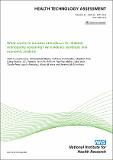What works to increase attendance for diabetic retinopathy screening? An evidence synthesis and economic analysis
Abstract
BACKGROUND: Diabetic retinopathy screening (DRS) is effective but uptake is suboptimal. OBJECTIVES: To determine the effectiveness of quality improvement (QI) interventions for DRS attendance; describe the interventions in terms of QI components and behaviour change techniques (BCTs); identify theoretical determinants of attendance; investigate coherence between BCTs identified in interventions and determinants of attendance; and determine the cost-effectiveness of QI components and BCTs for improving DRS. DATA SOURCES AND REVIEW METHODS: Phase 1 - systematic review of randomised controlled trials (RCTs) evaluating interventions to increase DRS attendance (The Cochrane Library, MEDLINE, EMBASE and trials registers to February 2017) and coding intervention content to classify QI components and BCTs. Phase 2 - review of studies reporting factors influencing attendance, coded to theoretical domains (MEDLINE, EMBASE, PsycINFO and sources of grey literature to March 2016). Phase 3 - mapping BCTs (phase 1) to theoretical domains (phase 2) and an economic evaluation to determine the cost-effectiveness of BCTs or QI components. RESULTS: Phase 1 - 7277 studies were screened, of which 66 RCTs were included in the review. Interventions were multifaceted and targeted patients, health-care professionals (HCPs) or health-care systems. Overall, interventions increased DRS attendance by 12% [risk difference (RD) 0.12, 95% confidence interval (CI) 0.10 to 0.14] compared with usual care, with substantial heterogeneity in effect size. Both DRS-targeted and general QI interventions were effective, particularly when baseline attendance levels were low. All commonly used QI components and BCTs were associated with significant improvements, particularly in those with poor attendance. Higher effect estimates were observed in subgroup analyses for the BCTs of 'goal setting (outcome, i.e. consequences)' (RD 0.26, 95% CI 0.16 to 0.36) and 'feedback on outcomes (consequences) of behaviour' (RD 0.22, 95% CI 0.15 to 0.29) in interventions targeting patients and of 'restructuring the social environment' (RD 0.19, 95% CI 0.12 to 0.26) and 'credible source' (RD 0.16, 95% CI 0.08 to 0.24) in interventions targeting HCPs. Phase 2 - 3457 studies were screened, of which 65 non-randomised studies were included in the review. The following theoretical domains were likely to influence attendance: 'environmental context and resources', 'social influences', 'knowledge', 'memory, attention and decision processes', 'beliefs about consequences' and 'emotions'. Phase 3 - mapping identified that interventions included BCTs targeting important barriers to/enablers of DRS attendance. However, BCTs targeting emotional factors around DRS were under-represented. QI components were unlikely to be cost-effective whereas BCTs with a high probability (≥ 0.975) of being cost-effective at a societal willingness-to-pay threshold of £20,000 per QALY included 'goal-setting (outcome)', 'feedback on outcomes of behaviour', 'social support' and 'information about health consequences'. Cost-effectiveness increased when DRS attendance was lower and with longer screening intervals. LIMITATIONS: Quality improvement/BCT coding was dependent on descriptions of intervention content in primary sources; methods for the identification of coherence of BCTs require improvement. CONCLUSIONS: Randomised controlled trial evidence indicates that QI interventions incorporating specific BCT components are associated with meaningful improvements in DRS attendance compared with usual care. Interventions generally used appropriate BCTs that target important barriers to screening attendance, with a high probability of being cost-effective. Research is needed to optimise BCTs or BCT combinations that seek to improve DRS attendance at an acceptable cost. BCTs targeting emotional factors represent a missed opportunity to improve attendance and should be tested in future studies. STUDY REGISTRATION: This study is registered as PROSPERO CRD42016044157 and PROSPERO CRD42016032990.
Citation
Lawrenson , J G , Graham-Rowe , E , Lorencatto , F , Rice , S , Bunce , C , Francis , J J , Burr , J M , Aluko , P , Vale , L , Peto , T , Presseau , J , Ivers , N M & Grimshaw , J M 2018 , ' What works to increase attendance for diabetic retinopathy screening? An evidence synthesis and economic analysis ' , Health Technology Assessment , vol. 22 , no. 29 . https://doi.org/10.3310/hta22290
Publication
Health Technology Assessment
Status
Peer reviewed
ISSN
1366-5278Type
Journal article
Description
Funding: The National Institute for Health Research Health Technology Assessment programme.Collections
Items in the St Andrews Research Repository are protected by copyright, with all rights reserved, unless otherwise indicated.

